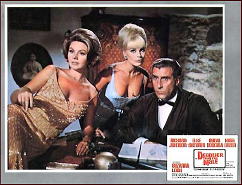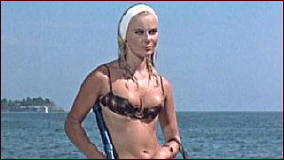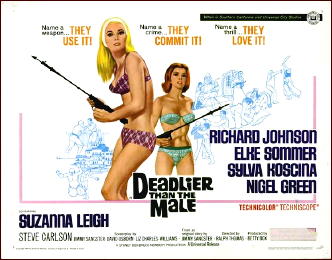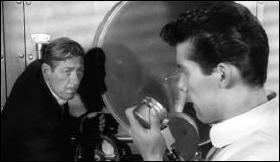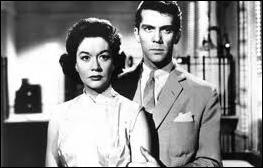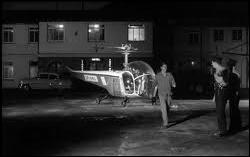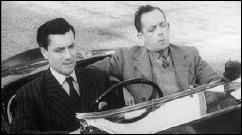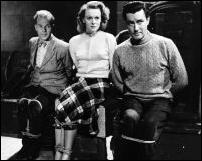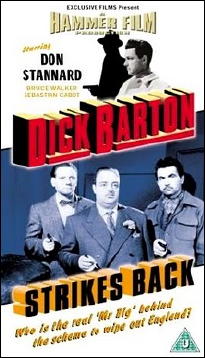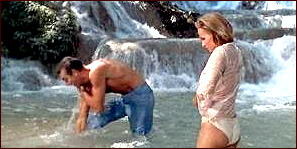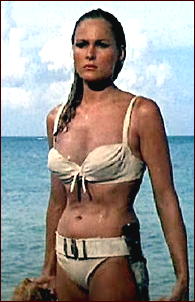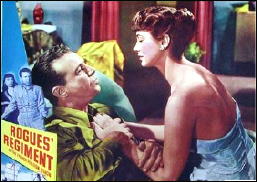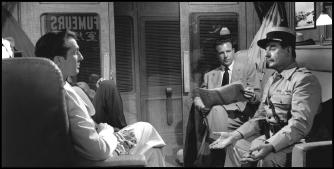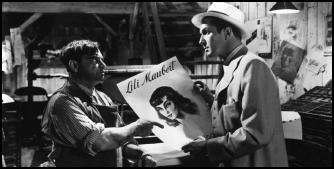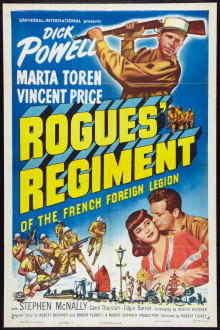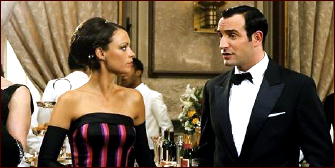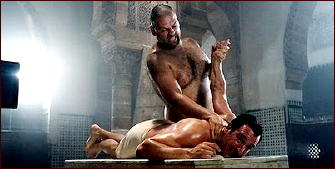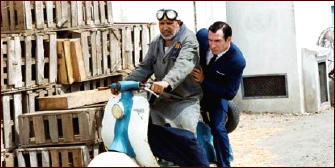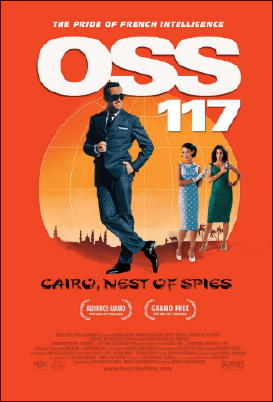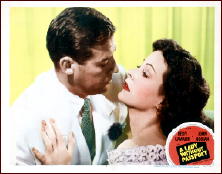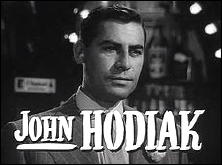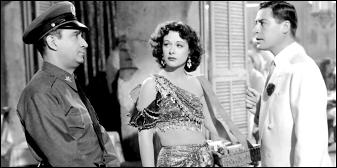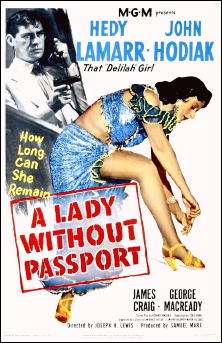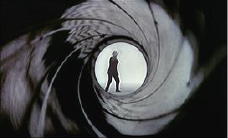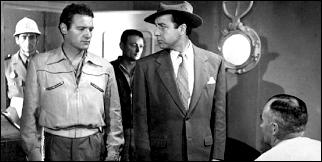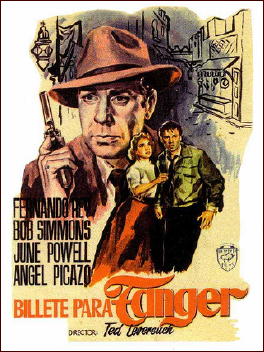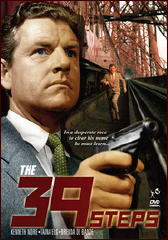
THE 39 STEPS. J. Arthur Rank, 1959. Kenneth More (Richard Hannay), Taina Elg, Brenda De Banzie, Barry Jones, Reginald Beckwith, Faith Brook, Michael Goodliffe, James Hayter, Joan Hickson, Sid James. Based on the book by James Buchan. Director: Ralph Thomas.
Based on the book, naturally, just as it says, but if truth be told, this version of the several films made of Buchan’s novel follows the Hitchcock version of 1935, the one with Robert Donat, more than the original text. Not that there’s anything wrong with that, of course!
So, how does it compare to the 1935 version? Can it possibly be better? It’s in color, which is somewhat of a plus, and even though the Scottish highlands are beautiful in color, there’s something to be said about the edge you get when you see them in black and white.
Kenneth More in this later film is more than up to the role, but he’s still no Robert Donat. As for Finnish actress Taina Elg, she was also a ballet dancer, and her legs are certainly up the role – which leads us straight to one of the better scenes of the movie, if you were to ask me.
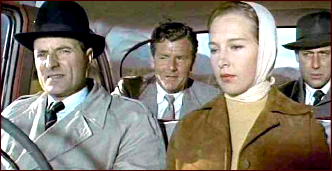
The story: When a woman he knows to be a spy is killed in Hannay’s apartment, and knowing time is of the essence in terms of the undercover plot she was working on, and based on what he has learned and knowing that waiting for the police to sort things out will take too long , he decides to bolt and make his way to Scotland – with half of Scotland Yard hot on his trail, or so it seems.
Whereby he connects up with the totally innocent Taina Elg (Fisher), first once on a train, then again later, whether she likes it or not, and of course she doesn’t, although she has no choice in the matter.
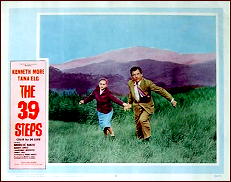
Hannay also meets, in pasing, several well-known British character actors, which probably helped to make this movie very popular in England at the time. It’s now many years later, however, and if you — like me — are a long way from the British Isles, the cast may be mostly incidental.
All in all, this is an enjoyable diversion, but in its running time of barely 90 minutes (the same as the 1935 version) the story seems rushed and out of breath for most of its time on the screen. It’s one of those cases, I suppose, where the reviewer ends by saying, “Your mileage may vary.â€
THE 39 STEPS. Made for British TV movie: BBC, 28 December 2008. Rupert Penry-Jones (Richard Hannay), Lydia Leonard, David Haig, Patrick Malahide, Patrick Kennedy, Hellory Sinclair, Eddie Marsan. Screenplay: Lizzie Mickery, based on the novel by John Buchan. Director: James Hawes.
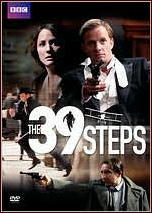
This more recent version of Buchan’s book follows the novel more closely than Hitchcock did, and consequently, more than the film with Kenneth More. (See above.) Of course there has to be a romantic interest in any adaptation of the book – doesn’t there? – and so there is in this one as well.
Which makes the gender of the screenwriter important, or so it seems. The girl, or rather the very capable woman Richard Hannay meets in this BBC production is a suffragette, a grand champion for the right of women to vote in this dramatic adventure taking place in Britain in the dark days before World War I. It’s all about German spies, German sympathizers, a coded notebook and (eventually) a reference to the mysterious thirty-nine steps.
The novel, once again, rather than Hitchcock’s version is therefore the model, but only the model. (There is a scene, however, in which Hannay is fired upon by a wonderfully antique cropduster biplane while he’s being chased against the Scottish countryside, just to remind the viewer, that the master director was not entirely forgotten.)
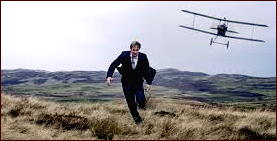
But twist follows upon delightful twist, so much so that I guarantee you that your head will be spinning by the time you get to the end of the film. Delightful, I repeat, and I mean it (most TV critics did not think highly of it at the time, and that’s an understatement), but in retrospect there’s at least one and a half twists too many. I fear that if I were to watch it again (and I may) the story line would not make any sense at all.
Most of the cast will be unfamiliar to audiences in the US, so again there are no distractions there. Hannay is played by Rupert Penry-Jones, previously the star of the British TV espionage thriller MI-5. He was also said to be in the running to play James Bond at one time , but while he’s very definitely athletic and handsome, he doesn’t seem to have the magnetism and screen presence of, say, a Daniel Craig.
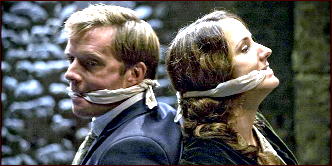
The other of the two leading characters constantly paired off with each other throughout the movie, the very capable Victoria Sinclair (I know, I’m repeating myself), well played by Lydia Leonard, a relative unknown, is often … let’s say extremely efficient and effective and say no more.
There is a scene, by the way, in which the pair are handcuffed together – no surprise there? – but its significance is cut short, alas, by a resolution that comes far too quickly, while the ending asks more questions than are answered, but to my mind, there’s nothing wrong with that.
Trailer: 1935 version (poor sound).
Trailer: 1959 version.
Video clips: 2008 version.
